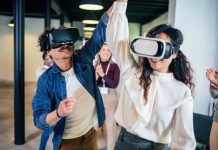Our biases can override rational decisions and logical thinking. Our decision- making skills may not be as robust or objective as we believe them to be. The instances of bias, prejudice, and stereotyping aren’t always obvious either, and bias-based decisions and behavior can limit creativity and opportunity. All of these factors combined can have a significant impact on performance, productivity, and your bottom line.
Whether you’re trying to attract or retain talented people, or set the stage for creative growth and innovation, unconscious bias should be at the forefront of your hiring and management processes.
We believe that helping your employees recognize their unconscious bias starts with learning. Through storytelling, coaching, e-learning courses, and custom developed e-learning programs, we challenge learners to apply concepts to their daily work routine.
Learning can be presented and disseminated in many ways, and we’re constantly looking for the best way to help tell the story of diversity and unconscious bias in the workplace. Sometimes innovation means trying something new, and sometimes it means recycling something old.
That’s why we’ve introduced an unconscious bias comic strip as one of the key components of our Unconscious Bias course. Click here to view an example.
Why Comics?
Many learners today are more visual than ever, with attention spans to match, so a simple comic strip grabs the reader’s imagination by communicating large amounts of information and narrative in a short time frame.
Plus, quite simply, people love comics. With so much dry and unengaging content to slog through on a daily basis, comic strips are a light-hearted break to more serious work reading, and a way to get the deeper message across with almost limitless creative ways to use imagery, visual tone, and color to communicate the concept.
This has been proven to be effective in teaching social studies and science-based subjects, as processing images leads to be better recall of the learning for practical use. “With comics, students not only learn the material faster, they learn it better,” says Josh Elder, founder and president of Reading With Pictures.
The 3 Es
Elder goes on to describe three ways in which comics help learners learn better:
- Engagement: Comics impart meaning through the reader’s active engagement with written language and juxtaposed sequential images. Readers must actively make meaning from the interplay of text and images, as well as by filling in the gaps between panels.
- Efficiency: The comic format conveys large amounts of information in a short time. This is especially effective for teaching content in subject areas such as math, science, social studies, etc.
- Effectiveness: Processing text and images together leads to better recall and transfer of learning. Neurological experiments have shown that we process text and images in different areas of the brain. This is known as the Dual-Coding Theory of Cognition. These experiments also indicate that pairing an image with text leads to increased memory retention for both. With comics, students not only learn the material faster, they learn it better.
We hope you’ll enjoy the comic we’ve created on unconscious bias in hiring processes and that you’ll share it with your HR team and on social media and start a conversation about unconscious bias on your team.
From law firms to health services and major pharmaceutical organizations, Marshall E-Learning help companies all over the UK and internationally to understand unconscious bias and how it can cost their team if a diverse skill set is lacking, or how a team can affect a range of situations and negatively impact the business with unnecessary discrimination in the workplace. For more information, visit: http://marshallelearning.com/contact




